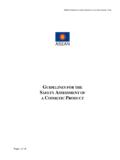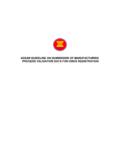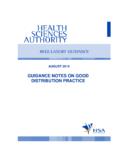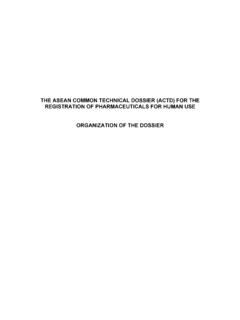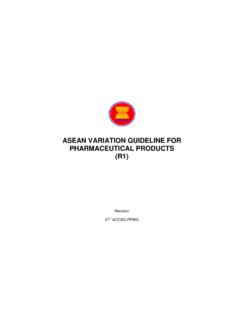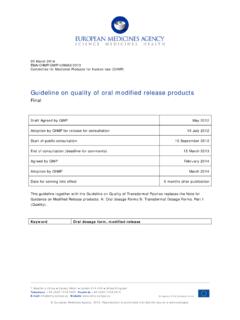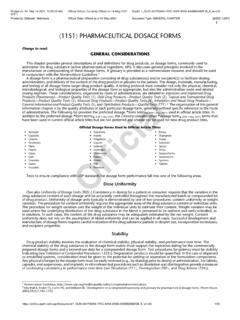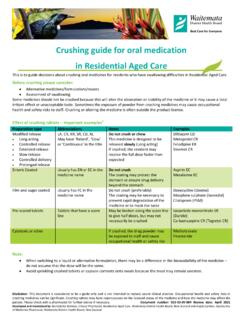Transcription of ASEAN GUIDELINE ON SUBMISSION OF MANUFACTURING …
1 ASEAN GUIDELINE ON SUBMISSION OF MANUFACTURING PROCESS VALIDATION DATA FOR DRUG REGISTRATION 1 TABLE OF CONTENTS 1. INTRODUCTION .. 2 2. SCOPE .. 2 3. DATA SUBMISSION REQUIREMENTS .. 2 4. CONTENT OF DEVELOPMENT PHARMACEUTICS ..3 5. CONTENT OF VALIDATION SCHEME .. 3 6. CONTENT OF VALIDATION REPORT .. 4 7. NOTES ON RETROSPECTIVE VALIDATION & CONCURRENT VALIDATION .. 4 8. CHANGE CONTROL .. 5 9. TABLE OF CONTENTS OF PROCESS VALIDATION DOCUMENTATION .. 5 10. QUALITY BY DESIGN AS AN ALTERNATIVE APPROACH TO PROCESS VALIDATION .. 5 11. GLOSSARY .. 5 12. DOCUMENT VERSION HISTORY .. 5 ANNEX A1 GUIDANCE ON PROCESS VALIDATION SCHEME FOR SOLID oral DOSAGE PRODUCTS ANNEX A2 GUIDANCE ON PROCESS VALIDATION SCHEME FOR ASEPTICALLY PROCESSED PRODUCTS ANNEX A3 GUIDANCE ON PROCESS VALIDATION SCHEME FOR TERMINALLY STERILISED PRODUCTS ANNEX B TABLE OF
2 CONTENTS OF PROCESS VALIDATION DOCUMENTATION ANNEX C GUIDANCE FOR QUALITY BY DESIGN AS AN ALTERNATIVE APPROACH TO PROCESS VALIDATION ANNEX D GLOSSARY 2 GUIDELINE ON SUBMISSION OF MANUFACTURING PROCESS VALIDATION DATA FOR DRUG REGISTRATION 1. INTRODUCTION Process Validation is a means of ensuring that MANUFACTURING processes are capable of consistently producing a finished product of the required quality. It involves providing documentary evidence that key steps in the MANUFACTURING process are consistent and reproducible.
3 A validated MANUFACTURING process is one that has been proven to do what it purports or is presented to do. The term `validation is intended to apply to final verification at the production scale. Typically a minimum of three consecutive production batches should be successfully validated prior to the marketing of the product. 2. SCOPE This GUIDELINE is intended to outline the regulatory requirements with respect to the MANUFACTURING process validation studies which fall under the remit of drug registration and to guide the applicant in preparing the dossiers for the product license and post-approval variation applications. These requirements are not intended for regulating the manufacture of active substance and other starting materials, but intended to apply to data generated to evaluate or validate the MANUFACTURING process of the finished product.
4 For biotechnological and biological products, more extensive data may be required. 3. DATA SUBMISSION REQUIREMENTS Option 1 - The data SUBMISSION should include a validation report (see Content of Validation Report) on three consecutive successfully validated production batches. Option 2 - In circumstances where SUBMISSION of data on 3 consecutive production batches is not feasible at the time of application, the following can be submitted to DRA to obtain marketing approval. Documents required: a) Development pharmaceutics report; and b) Validation data on 1 pilot batch with validation scheme on production scale batches. In addition, the applicant is required to fulfill the following standard commitments: To undertake that 3 consecutive full production batches are successfully validated before the product is marketed, subject to concurrence by the DRA; To submit the report to the Drug Regulatory Authority (DRA) within a specified time frame, or to make the information from these studies available for verification post authorisation by DRA according to national procedure.
5 Note: Option 2 is not recommended for biological/biotechnological product, product manufactured using non standard method of manufacture, such as non-standard methods of sterilization and aseptic processing, and other specialized products such as modified release dosage form. Option 3 - For products that have been approved by a reference agency, the applicant is required to provide a declaration statement to the effect that the same pre-approval dossiers pertaining to 3 process validation that have been submitted to the reference regulatory agency are submitted to DRA for evaluation. Under certain circumstances where validation documents may not form part of the pre-approval dossiers, the DRA may request for Validation Report or Validation Scheme. In addition, the applicant is required to undertake that 3 consecutive full production batches are successfully validated before the product is marketed and to submit the report to DRA upon request.
6 4. CONTENT OF DEVELOPMENT PHARMACEUTICS The report on pharmaceutical development or development pharmaceutics should address the following: a) Rationale for selecting the dosage form b) Choice of product components (Active substance and excipients) Compatibility considerations Physico-chemical characteristics c) Formulation of product Use of overages Effect of pH and other parameters Effect of antioxidants, solvents, chelating agents, type/concentration of anti-microbial agents, etc Stability, homogeneity and batch reproducibility considerations d) Choice of MANUFACTURING processes, including sterilization procedures e) Choice of containers and packaging materials Container-closure integrity Sorption and leaching issues f) Microbial attributes of dosage form g) Compatibility of drug product with diluents or dosage device ( precipitation of drug substance in solution, sorption on injection vessels etc)
7 Throughout shelf life of drug product The development pharmaceutics report should establish that the type of dosage form selected and the formulation proposed are appropriate for the intended (medicinal) purpose specified in the application for drug registration. It should also identify the formulation and processing aspects that are critical for batch homogeneity and reproducibility, and that hence have to be monitored routinely. The development pharmaceutics report (and the pilot batch report) should provide a link to the validation scheme proposed for the manufacture of production scale batches. 5. CONTENT OF VALIDATION SCHEME Process validation scheme outlines the formal process validation studies to be conducted on the production scale batches. It should contain, but not limited to, the following information.
8 A) A description of the MANUFACTURING process with a schematic drawing or flow chart b) A summary of the critical processes, control variables and justification for their selection c) Finished product specification ( release ) 4 d) Details of analytical methods (reference to the dossier) e) In process controls proposed with acceptance criteria f) Additional testing intended to be carried out ( With proposed acceptance criteria and analytical validation appropriate) g) Sampling plan where, when and how samples are taken h) Details of methods for recording and evaluation of results i) Proposed time frames for carrying out the studies j) Critical equipment/facilities to be used (for example, measuring/recording equipment together with its qualification and calibration status) 6. CONTENT OF VALIDATION REPORT The content of report should include, but not limited to the following information: a) Summary b) Introduction c) Batches (for example, date of manufacture, batch size) used for validation d) MANUFACTURING equipment e) Critical process steps and parameters f) Acceptance criteria g) Sampling plan h) Tabulation of the test results i) Batch Analysis j) Evaluation of data, including statistical process control analysis k) Evaluation of data including comparison against acceptance criteria l) Discussion on deviations and out of specification results m) Conclusion and recommendations Where appropriate a description of the MANUFACTURING process with a schematic drawing or flow chart may be required by the DRA.
9 Please refer to annexes listed below: a) Annex A1 for guidance on process validation scheme for solid oral dosage products, b) Annex A2 for guidance on process validation scheme for aseptically processed products and; c) Annex A3 for guidance on process validation scheme for terminally sterilized products. 7. NOTES ON RETROSPECTIVE VALIDATION & CONCURRENT VALIDATION Retrospective Validation For existing products already on the market for some time, retrospective validation may be performed. Retrospective validation involves the trend analysis (using control chart, etc) of historical MANUFACTURING and QC data (eg. Results of assays, dissolution test, pH, SG, etc) of the product. Data from 10-20 batches of the product produced using the same stable MANUFACTURING process should be analysed, to demonstrate that the MANUFACTURING process is under control and `capable.
10 A Cpk (Process Capability) and/or Ppk (Process Performance) of , and represents a 3, 4, 6 sigma respectively. The measurement of Cp, Cpk, Pp or Ppk will be accepted as one of the statistical methods for analysing the process control. Concurrent Validation In the case of orphan drugs, when the number of production batches per year is expected to be low, concurrent validation is acceptable. Other categories of drugs for which have short 5 lives ( radiopharmaceuticals) and that are medically necessary ( drug used to prevent or treat serious or life-threatening disease or medical condition, for which there is no other available source with sufficient supply of that drug or alternative drug available) may be considered on case by case basis. The applicant should seek prior consent from DRA before submitting the application to register any drug product that uses concurrent validation approach.
